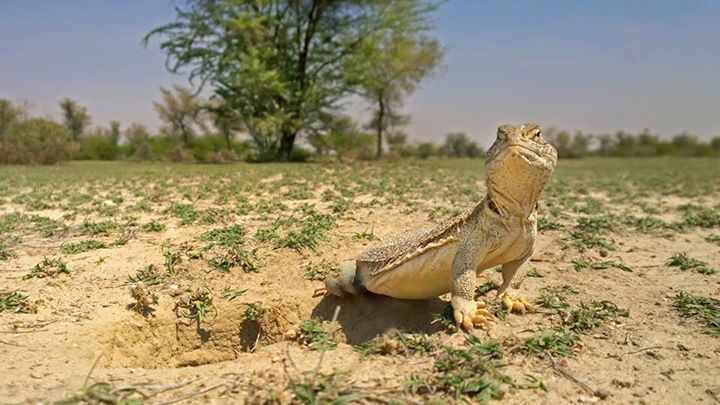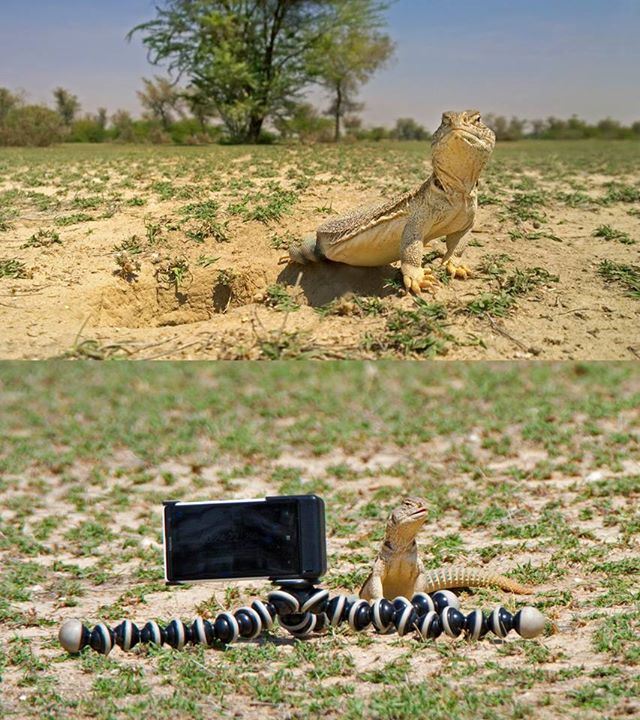How I clicked this Spiny Tailed Lizard With Habitat

A Spiny Tailed Lizard Outside its burrow
I have been fascinated by a lot of the smaller forms of life, which unfortunately often don’t get as much attention as some of the larger and more well known species in the same places they inhabit. I have often attempted to depict these animals in their habitats, so that we know that these habitats hold not just the tigers, leopards or raptors, but an innumerable number of smaller forms of life, all of which are equally essential for the habitat to thrive. However, trying to shoot a habitat image of small animal brings with it a different set of challenges. Firstly, these animals are very skittish, and do not allow us to come close at all – with or without a camera.
Secondly a DSLR (even if the camera is nicely concealed and camouflaged) is quite large as compared to the size of these animals. Small burrowing animals like the spiny tailed lizard or the jird don’t seem to be very comfortable with something that big just outside their burrows. My guess is that they probably see them as a danger/prey, and do not venture out.
So let me share with you how I made this picture of the Spiny Tailed Lizard in Tal Chapar Sanctuary in Rajasthan.
The picture was made using the following
- A Cell phone
- Gorilla Pod
- An App called Pro Shot
A camera phone is much less bulky and these small animals aren’t very intimidated by it. They accept its presence and carry on with their business, like in the image below. I plan to explore some more imaging apps on the Android, sometime in the coming months – do let me know if you know any good ones.
The very first time I tried using the Nokia 1020, was during a trip in Kaas, those images can be seen here. I felt that it was a great camera to shoot macro-scapes. It is particularly handy while shooting some of these burrowing animals that have a fair tolerance for people so long as they are 20 feet away, but run into their burrows once that distance is breached. That being said, a few things to keep in mind in case you plan to use this, or camera phones in general, while shooting macros are:
1. Most camera phones are good wide angle lenses, at the equivalent of 20-24 mm on a full frame.
2. Most of them are constant apertures – f 2.0 – f 2.4. This means that the DOFs, despite the wide angle, are fairly shallow. So one must be careful to set the focal point in the frame correctly, for pretty much anything else falling outside it will be out of focus. This becomes even more important if one is trying to shoot subjects that will be moving. I have had instances when the lizard’s body would be in focus, but given how close it can come to the lens, the face was completely out of focus. The one way to go about it would be to assume where the subject is most likely to appear, set the focus at that point, compose the image around it and be willing to discard any other image.
3. If you are using an app, try to look for one which allows you to take images in the highest resolution. Most time-lapse apps on the mobile tend to not click images in the highest resolution or the best format the camera phone allows. Even the one I used – while the 1020 can store images in the DNG format, the pro shot app allows only JPEGs at a resolution of 72 PPI.
4. Duration between frames – should ideally be as low as possible – I had kept this at 3 seconds. I had kept it at 6 or 8 while shooting the Jird, and realized that I did not have a lot of frames that could have been very good.
5. It makes more sense, now that I think about it, to wirelessly trigger the camera, so that the exact moment can be chosen. I have an accessory that does this and plan to try it the next time. While it reduces the number of images I may have to deal with, it also allows me to shoot in the native DNG format. Most other camera phones have the volume up button on the headset doubled up as camera triggers. Wonder if the same works on a Bluetooth as well – that would be a nice remote trigger for these kind of images.
6. Battery. If a time lapse or similar app is used, it is going to be a battery draining app. So it would make sense to have a battery pack on. In my case, the grip that helps me mount the 1020 on the gorilla-pod is a battery back.
7. Remember to change the settings on your phone to never lock it, for most of these apps do not work when the phone gets locked.
8. As for image quality, it look good on my laptop screen and is perfect for sharing on Facebook etc.. However, it is never going to be the same as a DSLR, and that is anyway an unfair comparison to make.
9. Lastly, keep in mind the amount of time some of these burrowing animals take to come out of their burrows once disturbed. I noticed that a lizard takes about 10 minutes and a jird about 20 minutes. If after I had placed the camera outside their burrow they don’t come back in roughly the same time, I would pick up the equipment and go elsewhere, quite some distance away. It means that they aren’t comfortable with the equipment and may not come out at all – that is not something I would risk while photographing. I wouldn’t want my photography to come in the way of these animals going about their everyday business. So in case you are using this to photograph – request you to be as careful as possible.
Below is the image as it appeared finally and also how the Gorilla Pod and Cellphone setup was done to get the picture of the Spiny Tailed Lizard.

How to use Cell Phone for Photographing Small Animals
Hope this was useful. Do share any thoughts on how this could be improved, or anything else you feel could work for habitat shots of small animals.
If you have any questions please feel free to put them in comments or use the Ask Darter a question on Photography form to ask any question related to photography and one of our Darter Photographers will answer the same. Click here if would like to join our mentored wildlife photography tours with our expert photographers.
About the Author and Photographer:
 Anuroop Krishnan is a wildlife photographer based out of Gurgaon. He has received many awards, including the ‘Photographer of the Year’ in the macro category in 2013 in Better Photography’s Photographer of the year contest, one of India’s largest contests. His work has also been published in many places, including the cover of the Sanctuary Asia Magazine. Anuroop has also been featured in the expert panel of the ‘Better Photography Magazine’ in May 2014. Anuroop mentors our wildlife photography tours. You can find his works at www.anuroopkrishnan.com and connect with him on his Facebook page.
Anuroop Krishnan is a wildlife photographer based out of Gurgaon. He has received many awards, including the ‘Photographer of the Year’ in the macro category in 2013 in Better Photography’s Photographer of the year contest, one of India’s largest contests. His work has also been published in many places, including the cover of the Sanctuary Asia Magazine. Anuroop has also been featured in the expert panel of the ‘Better Photography Magazine’ in May 2014. Anuroop mentors our wildlife photography tours. You can find his works at www.anuroopkrishnan.com and connect with him on his Facebook page.
